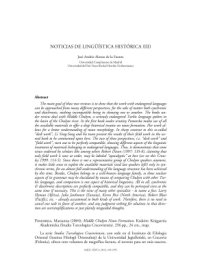
Ebook: On Middle Chulym historical linguistics (in Spanish)
Author: Fuente de la J.A.A.
- Genre: Linguistics // Foreign
- Tags: Языки и языкознание, Чулымский язык
- Language: Chulym-English
- pdf
International Journal of Basque Linguistics and Philology ASJU, xlvi-2, 2012, - 11 p.The main goal of these two reviews is to show that the work with endangered languages can be approached from many different perspectives, for the sake of matter both synchronic and diachronic, nothing incompatible being in choosing one or another. The books under review deal with Middle Chulym, a seriously endangered Turkic language spoken in the basin of the Chulym river. In the first book under scrutiny Pomorska makes use of all the available materials to offer a deep historical treatise on noun formation. Her work allows for a better understanding of noun morphology. In sharp contrast to this so-called “desk work”, Li Yong-Song and his team present the results of their field work in the second book to be commented upon here. The two of these perspectives, i.e. “desk work” and “field work”, turn out to be perfectly compatible, showing different aspects of the linguistic treatment of materials belonging to endangered languages. Thus, it demonstrates that some views endorsed by scholars like among others Robert Dixon (1997: 135-8), claiming that only field work is now at order, may be labeled “apocalyptic” at best (see on this Crowley 1999: 114-5). Since there is not a representative group of Chulym speakers anymore, it makes little sense to exploit the available materials (and last speakers left!) only in synchronic terms, for an almost full understanding of the language structure has been achieved by this time. Besides, Chulym belongs to a well-known language family, so those unclear aspects of its grammar may be elucidated by means of comparing Chulym with other Turkic languages, and comparison is one aspect of historical linguistics. All in all, synchronic & diachronic descriptions are perfectly compatible, and they can be portrayed even at the same time if necessary. This is the view of many other specialists - to name a few: Larry Hyman (Africa), Juha Janhunen (Eurasia), Keren Rice (North America), Robert Blust (Pacific), etc. - already accustomed to both kinds of work. Therefore, there is no need to cancel one task in favor of another, and any judgment seeking for solutions in that direction are oversimplifications or just plainly misguided thoughts.
Download the book On Middle Chulym historical linguistics (in Spanish) for free or read online
Continue reading on any device:

Last viewed books
Related books
{related-news}
Comments (0)